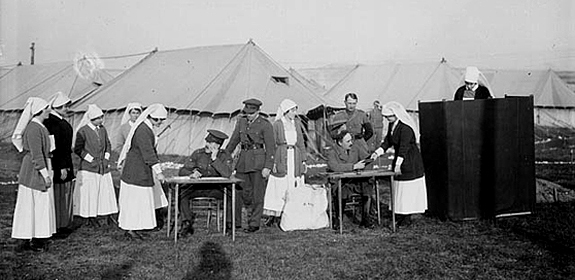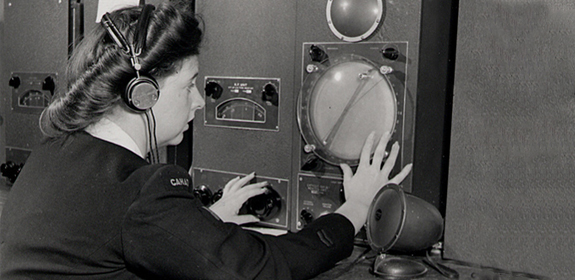Canada Remembers Women in the Canadian Military
This publication is available upon request in alternate formats.
PDF Version
Canadian women have played an important role in our country’s military efforts over the years, overcoming many barriers to serve in uniform as nurses and in an expanding variety of other roles. This service continues today, with females now serving alongside their male counterparts in all Canadian Forces trades.
The First World War
Canadian women’s first military contributions were as nurses who tended to the sick and wounded in times of conflict. They were called “Nursing Sisters” because they were originally drawn from the ranks of religious orders. More than 2,800 Canadian Nursing Sisters served with the Canadian Army Medical Corps during the First World War, often close to the front lines of Europe and within range of enemy attack. With their blue dresses and white veils, they were nicknamed the “bluebirds” and were greatly respected because of their compassion and courage. Canadian women were not permitted to serve in other military roles during the First World War.
The Second World War
The Second World War would see Canadian women returning to serve again as nursing sisters. This time, approximately 4,500 nurses were attached to all three branches of Canada’s military, with more than two-thirds of them serving overseas. Second World War nursing sisters wore a military uniform with a traditional white veil. These young women were commissioned officers and were respectfully addressed as “Sister” or “Ma’am.” In fact, Canada’s military nurses were the first in any Allied country to have officer status. Canadian women would also serve in other military roles during the war, however, and some 50,000 eventually enlisted in the air force, army and navy.
Royal Canadian Air Force - Women’s Division (RCAF-WD)
On July 2, 1941 the Women’s Division of the Royal Canadian Air Force (RCAF) was created—a first for our country. By the end of the war it totalled some 17,000 members. The RCAF did not train their female recruits to be flying instructors or combatants (indeed, the spirit of their participation is best described by the division’s slogan, “We serve that men may fly”). They were initially trained for clerical, administrative and support roles. As the war continued, however, women would also work in other positions like parachute riggers and laboratory assistants, and even in the very male-dominated electrical and mechanical trades. Many RCAF-WD members were sent to Great Britain to serve with Canadian squadrons and headquarters there.Canadian Women’s Army Corps (CWAC)
The CWAC was officially established on August 13, 1941 and by war’s end, it had some 21,000 members. Initially, CWAC members’ duties were quite traditional and they worked as cooks, cleaners, tailors and medical assistants. However, these duties would expand to include more traditionally male jobs such as driving trucks and ambulances, and working as mechanics and radar operators. While most CWACs served in Canada, three companies of female soldiers were posted overseas in 1943.Women’s Royal Canadian Naval Service (WRCNS)
The Women’s Royal Canadian Naval Service (whose members were familiarly known as the “Wrens” after the nickname of their British Royal Navy counterparts), was officially established on July 31, 1942. The last Canadian military branch to recruit women, the Wrens grew to number some 7,000. They initially performed clerical and administrative tasks so more men could be made available for duty at sea. Eventually, Wrens would expand on these roles as well to do things like being on-shore radar operators and coding technicians.
Post-Second World War
After the Second World War, the Canadian military shut down the women’s organizations. With the onset of the Cold War and the Korean War, however, the military soon faced a shortage of personnel and some 5,000 women were again actively recruited. While only a handful of nursing sisters were sent to Korea, some servicewomen back in Canada filled the same kinds of roles they had during the Second World War. Their numbers began to decline in the mid-1950s, however, as new technology reduced the requirement for personnel in many trades.
With the unification and modernization of the Canadian military in the late 1960s, the doors finally began to open for good for women to enlist and enter non-traditional roles. Today, women deploy on combat missions, captain vessels and command flying squadrons—their career paths as open as those of men.
Sacrifice
Canadian women who chose to serve in the cause of peace and freedom during the war years had to endure and overcome the inequalities of the Canadian society of the day. For example, women’s pay remained lower than that of men of similar rank during the Second World War and military women sometimes faced criticism from those who felt that a woman’s place was in the home.
When women chose to enlist in the military, they also volunteered to potentially put themselves in dangerous situations where their lives were on the line. Canada’s nursing sisters in particular found themselves in peril, as they often served in field hospitals close to the fighting. More than 40 of these brave women died during the First World War, losing their lives in enemy bombardments of field hospitals, attacks on shipping and due to the sickness that often comes with the harsh conditions of war. The Second World War would see many more women participate in the military with one nursing sister, Sub-Lieutenant Agnes Wilkie, dying when the ferry SS Caribou was torpedoed by a German U-boat while crossing from Cape Breton to Newfoundland. Seven RCAF-WD members also died in service during the war.
These dangers continue today as the evolving roles of women in the Canadian Forces move them into perilous new duties. For example, Captain Nicola Goddard, a forward artillery observer, died in a firefight in Afghanistan in 2006. She was the first Canadian women to be killed while serving in a combat role.
Legacy
During the First and Second World Wars, many women felt they had a once-in-a-lifetime opportunity to enlist and help their country in any way that was needed. Their changing roles during these turbulent years helped lead to great changes in the way society looked at women. Their service and sacrifice during the First World War helped influence the decision to grant federal voting rights to many Canadian women in 1917. The efforts of these pioneering women helped open the door for the women who now serve in a broad array of roles in the Canadian Forces today.
Canada Remembers Program
Women have not only made great contributions in uniform, they also played a vital role in our country’s war efforts on the home front. Learn more about the many ways that Canadian women helped support those fighting overseas by exploring the Canada Remembers Women on the Home Front historical sheet.
The Canada Remembers Program of Veterans Affairs Canada encourages all Canadians to learn about the sacrifices and achievements made by those who have served—and continue to serve—during times of war and peace. As well, it invites Canadians to become involved in remembrance activities that will help preserve their legacy for future generations.
- Date modified:


